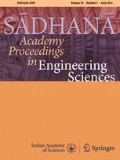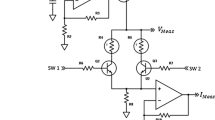Abstract
This paper describes the design of a miniature air suction system to house a chemical sensor. It has been designed to improve the aerodynamic chemical sensing efficiency and to have a low weight since it is meant to be mounted on a micro air vehicle. The design is done around a readily available miniature axial flow fan by computational methods. A converging-diverging shape for the air suction system with the sensor disc having a central hole and mounted at the throat is proposed as good design concept. The systematic approach has led to a light weight system with high aerodynamic efficiency even under extreme flow conditions that may be caused by MAV manoeuvre or cross winds.






















Similar content being viewed by others
Abbreviations
- D 1, D 2, D 3, L 1, L 2 :
- d :
-
diameter of the hole in the sensor disc plate (mm)
- L :
-
total length of the air suction duct = 30 mm
- p :
-
pressure (Pa)
- Q :
-
volumetric flow rate (lpm)
- T :
-
torque (N-m)
- v :
-
velocity (m/s)
- V ∞ :
-
velocity of the MAV carrying the air suction device (m/s)
- z :
-
fan axis and also flow direction
- α :
-
angle of attack of air suction device with freestream (deg)
- ρ :
-
density of air (kg/m3)
- τ w :
-
wall shear stress (Pa)
- ω :
-
fan rotational speed (rad/s)
References
Soderman P T, Hazen N L and Brune WT 1991 Aerodynamic design of gas and aerosol samplers for aircraft. NASA TM 103854
Perajarvi K, Lehtinen J, Pollanen R and Toivonen 2008 Design of an air sampler for a small unmanned aerial vehicle. Radiation Protection Dosimetry 132: 328-333
Pollanen R, Toivonen H, Perajarvi K, Karhunen, T, Ilander T, Lehtinen J, Rintala K, Katajainen T, Niemela J and Juusela M 2009 Radiation surveillance using an unmanned aerial vehicle. Applied Radiation and Isotopes 67: 340-344
Settles G S and Kester D A 2001 Aerodynamic sampling for landmine trace detection. SPIE Aeroscience 4394, Paper 108
Settles G S 2005 Sniffers: Fluid-dynamic sampling for olfactory trace detection in nature and homeland security. J. Fluids Eng. 127: 189-217
Sharan M and Gopalakrishnan S G 1997 Bhopal gas accident: A numerical simulation of the gas dispersion event. Environmental Modelling & Software 12: 135-141
Ho C K, Itamura M T, Kelley M and Hughes R C 2001 Review of chemical sensors for in-situ monitoring of volatile contaminants. Sandia Report SAND2001-0643
Siadat M, Losson E, Ahmadou D and Lumbreras M 2014 Detection optimization using a transient feature from a metal oxide gas sensor array. Sensors & Transducers 27: 304-346
Liu H, Zhang L, Li K H H and Tan O K 2018 Microhotplates for metal oxide semiconductor gas sensor applications – Towards the CMOS-MEMS monolithic approach. Micromachines 9: 1-24
Holman J P 2009 Heat Transfer. 10th edn. New York: McGraw-Hill
Bejan A 2013 Convection Heat Transfer. 4th edn. New Jersey: Wiley
Judy J W 2001 Microelectromechanical systems (MEMS): fabrication, design and applications, Smart Materials and Structures 10: 1115-1134
Wallis R A 1983 Axial Flow Fans and Ducts. New York: John Wiley
Eck B 1972 Fans: Design and Operation of Centrifugal Axial Flow and Cross Flow Fans. Oxford: Pergamon
Bleier F P 1997 Fan Handbook: Selection Application and Design. New York: McGraw-Hill
Quin D and Grimes R 2008 The effect of Reynolds number on microaxial flow fan performance. J. Fluids Eng. 130: 101101
Kearney D, Grimes R and Punch J 2009 An experimental investigation of the flow fields within geometrically similar miniature-scale centrifugal pumps. J. Fluids Eng. 131: 101101
Walsh P A, Walsh E J and Grimes R 2010 Viscous scaling phenomena in miniature centrifugal flow cooling fans: Theory, experiments and correlation. J. Electron. Packag. 132: 021001
Grimes R, Davies M, Punch J, Dalton T and Cole R 2001 Modeling electronic cooling axial fans. J. Electron. Packag. 123: 112-119.
Lin S-C and Tsai M-L 2010 An integrated performance analysis for a small axial-flow fan. J. Mech. Eng. Sci. 224: 1981–1994
Lin S-C and Tsai M-L 2011 An integrated study of the design method for small axial-flow fans, based on the airfoil theory. J. Mech. Eng. Sci. 225: 885–895
Deshpande M D, Sivapragasam M and Umesh S 2014 Air suction system for chemical sensor for MAV application. Compendium on Advances in Micro Air Vehicles in India, National Design and Research Forum, Bengaluru
Celik I B, Ghia U, Roache P J, Freitas C J, Coleman H and Raad P E 2008 Procedure for estimation and reporting of uncertainty due to discretization in CFD applications. J. Fluids Eng. 130: 078001
Deshpande M D, Sivapragasam M and Umesh S 2015 Apparatus for enhancing aerodynamic sensitivity of a chemical sensor, Indian patent application number: 7093/CHE/2015
Acknowledgements
We thank the Department of Science and Technology (DST), New Delhi for funding this project; the Programme Office, National Programme on Micro Air Vehicles (NP-MICAV), Aeronautical Development Establishment, Bengaluru for sanctioning and monitoring the project; and the National Design and Research Forum (NDRF), Bengaluru of the Institution of Engineers (India) for coordinating the project.
Author information
Authors and Affiliations
Corresponding author
Rights and permissions
About this article
Cite this article
Deshpande, M.D., Sivapragasam, M. & Umesh, S. An efficient miniature air suction system for chemical sensors for micro air vehicle application. Sādhanā 45, 116 (2020). https://doi.org/10.1007/s12046-020-01352-y
Received:
Revised:
Accepted:
Published:
DOI: https://doi.org/10.1007/s12046-020-01352-y




